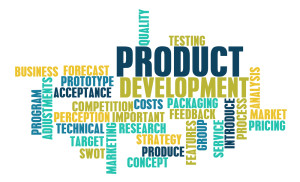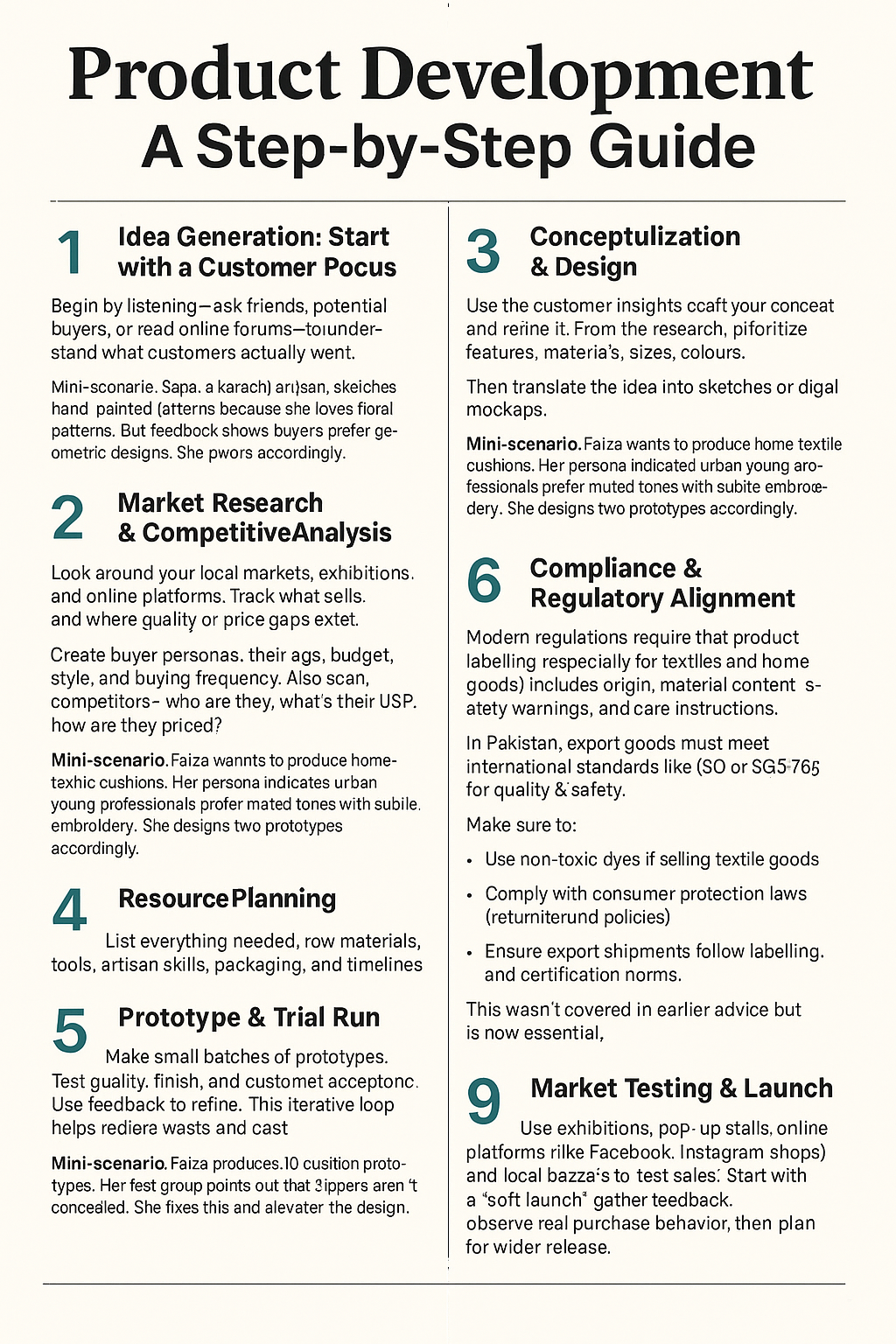Product Development
Product Development - for an idea
Product Development is an area that most of the women starting up their businesses take for granted. They assume that they are aware of all that is needed to know to make their goods. However, from the perspective of initiating a business, it is essential to have an idea and a product in mind.
The process of product development entails - idea generation - researching the idea - designing the product - trial runs - launch.

Courtesy: tom-gray.com
Product Development–A Step-by-Step Guide for Entrepreneurs
Whether you're launching a handcrafted home item or a lifestyle product, turning your idea into something real—something people love and buy—takes structure. It’s not just about creativity, but also strategy and listening to your market. This step-by-step guide walks you through the product development journey, with examples and tips tailored to small business owners and women entrepreneurs in Pakistan.
1. 🧠 Idea Generation – Start With Your Customer
Every great product begins with a spark. Maybe it's a fabric design you saw at a local fair, or a clever fix to a problem your friends complain about. But here’s the golden rule: what you love isn’t always what your customer wants. So before investing time and money, start by understanding the market.
Mini-scenario: Zara, an artisan in Karachi, loves intricate floral lanterns.
But after talking to buyers and browsing Instagram trends, she notices
customers lean toward modern, geometric patterns. She tweaks her designs to
reflect that.
A simple way to start? Ask your friends what they’d buy. Scroll through trending posts on Instagram or Facebook Marketplace. Check reviews on Daraz. The more you listen, the clearer your product idea will get. Talk to potential buyers. Visit local markets. Read product reviews online.
Your goal? Identify a real need or want.
2. 🔍 Research the Market & Scope Out the Competition
Now, take that idea and dive deep. Visit bazaars, scroll through Daraz, check out Instagram shops. What’s selling? What’s missing?
Make notes about your potential competitors:
- What are they offering?
- What’s their pricing like?
- Who’s buying from them?
At the same time, sketch a buyer persona—someone who’s likely to buy your
product. Is she a college student who loves sustainable goods? A new mom
looking for handmade nursery items? Knowing your customer will shape everything
that follows. Are they budget-conscious students or young professionals looking for quality and style? Your “ideal customer” will guide your design and pricing.
Mini-scenario: Faiza wants to sell embroidered cushion covers. Her research
shows younger customers prefer minimal, neutral tones over bright traditional
ones. That insight helps shape her design choices.
3. ✏️ Sketch It Out – Design with Direction
Conceptualize & Design
Here’s where creativity meets direction.
Based on your research, develop product concepts. Start with sketches or mood
boards. If it’s handmade, prototype with different materials and finishes.
The key is to strike a balance between what excites you and what meets a clear
need in the market. Keep your customer persona in mind at all times.
Don’t forget the little details—product size, ease of use, how it will be
stored or cleaned. These small touches can make a big difference when a buyer
is deciding between you and a competitor.
Remember—good design is not just about looks. Think about durability, comfort, ease of use, and how it fits into someone’s daily life.
4. 📋 Plan What You’ll Need
Now that you have an idea and a rough design, list out your resources:
- Materials (fabric, beads, clay, etc.)
- Tools or machines
- Packaging
- Production time
- Budget for trial runs
Mini-scenario: Meher, who creates crochet accessories, realized she needed a tagging gun and brand labels to make her packaging look professional—something she hadn’t budgeted for at first.
Don’t forget to factor in time. If a single product takes too long to make, it may not be scalable.
Pro tip: Factor in a little buffer—things don’t always go according to plan!
As you embark on this phase, make a checklist as the first thing you do. The checklist should comprise of:
|
|
5. 🧪 Make a Prototype (and Be Ready to Tweak It)
Make a sample—just one or two pieces. This is where the magic happens. You’ll see what works, what doesn’t, and what needs to be fixed before you launch.
Mini-scenario: Rabia made 12 clay fridge magnets for her first batch. But they were too fragile. After a bit of testing, she switched to air-dry clay and added a protective gloss. That minor fix saved her from customer complaints.
Share your prototype with friends, family, or even social media followers. Honest feedback here can save you a lot of headache later.
6. ✅Regulatory Readiness & Product Compliance
Label It Right – Stay Compliant
This might not be the “fun” part, but it’s super important. Especially if you’re planning to sell online or ship internationally. This step is often overlooked—but it's crucial.
- Label everything clearly (especially for textiles, cosmetics, or home goods).
- Include content, origin, and care instructions.
- If it’s wearable, include fabric content and washing instructions.If it’s something for babies or homes, avoid toxic dyes and materials.
- If you’re planning to export, be aware of ISO standards, packaging requirements, and certifications.
- Follow consumer protection laws—have a return/refund policy if you're selling online.
Pakistan is seeing tighter enforcement of safety, hygiene, and e-commerce transparency. Be proactive. It builds trust and helps you avoid issues later.
7. 💡 Branding, Packaging & Pricing
This is where your product becomes a brand. Think about:
- Your logo and tagline
- The story behind your product
- Your tone (friendly, luxury, eco-conscious?)
Mini-scenario: Hina sells beeswax candles. She wraps them in reused kraft paper and ties them with jute twine. Her customers love the earthy, handmade vibe—and it matches her sustainable brand message.
Set your price based on cost, value, and positioning. You’re not just selling a product; you’re offering an experience.
8. 📢 Soft Launch & Market Testing
Before you go all-in, test the waters:
- Sell at a local event or flea market
- Post in Facebook groups
- Offer a giveaway to get attention
Track which products get the most attention. What colors sell fastest? What sizes are ignored?
Anecdote: Aliya put up three bag designs at a weekend market. Her smallest clutch sold out quickly, while the large tote barely got noticed. That insight helped her shift her focus instantly.
9. 🔁 Listen, Improve, Repeat
Even after launching, keep listening. Watch your customer messages, reviews, and return rates. Improvement never ends.
Make small changes over time. Adjust product details, add variations, or even discontinue what doesn’t work.
10. 🚀 Ready to Scale?
Once you’ve found what sells, you can grow.
- Buy materials in bulk
- Collaborate with artisans or helpers
- Expand into new designs or collections
But grow smart. Don’t lose your brand identity or quality in the rush to sell more.
More Real-Life Scenarios and Tips
To make your product development journey more relatable, here are a few more mini-scenarios and anecdotes that show how small changes lead to big results:
• Zara, from Islamabad, loved bold prints but her buyers preferred minimalist
designs—so she pivoted and sold out at her first pop-up.
• Nadia, a working mom, found a niche with breathable bamboo fabric baby wraps
that no one else in her market was offering.
• Farah started out making heavy jewelry sets. But her real success came after she introduced simple, lightweight earrings for everyday wear.
• Meher learned mid-way that professional packaging (like labels and tags) made
her crochet items look much more premium.
• Rabia's fridge magnets kept breaking—until she tried a sturdier clay and
sealed them with gloss. Now she gets bulk orders.
• Hina sells eco-friendly candles and wraps them in recycled paper and twine.
Her packaging reflects her values and draws eco-conscious buyers.
• Aliya tested her handmade bags at a weekend market and found her smallest
clutch bags sold out while large totes didn’t move—so she scaled production
based on real demand.
These stories aren’t just inspiring—they’re proof that staying flexible,
listening to feedback, and testing small can help you succeed faster without
wasting time or money.
🎯 Final Word– A Gentle Push Forward
Product development might sound like a big business term, but as you’ve seen—it’s just about listening, learning, and adjusting as you go. Start with curiosity, lead with care, and grow with intention.
You don’t need a massive team or factory floor. You just need a notebook, an
idea, and the courage to put it out into the world. Whether you’re selling
handmade soaps or embroidered tote bags, every step counts—and every small win
is worth celebrating.
So go ahead. Make your first prototype. Post that product online. Talk to your
buyers. Improve with each round. You’ve got what it takes.
You’ve got this. Let your idea grow—step by step.
Product Development - Outline of the process
As we develop an extensive and comprehensive book on the topic i.e.
"The Art and Science of Product Development: A Comprehensive Guide"; a brief outline for the process of product development is given below:

- Home
- Knowledge Base
- Product Development


